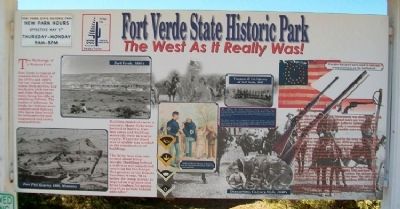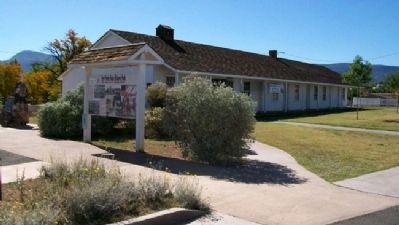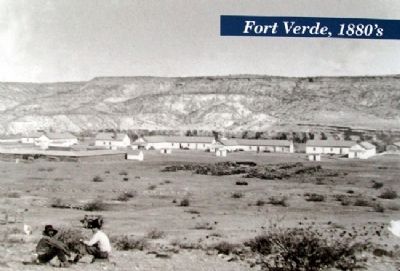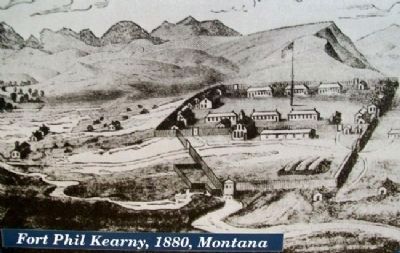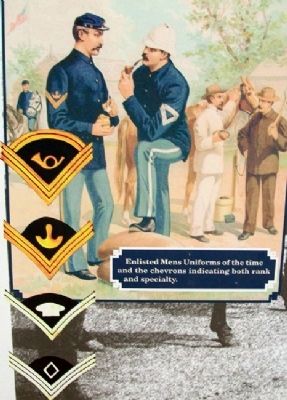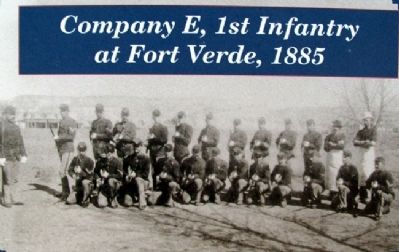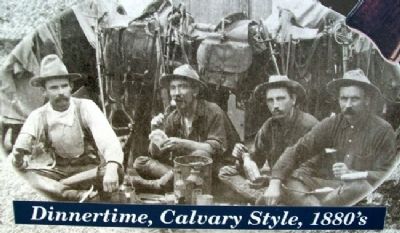Camp Verde in Yavapai County, Arizona — The American Mountains (Southwest)
Fort Verde State Historic Park
The West As It Really Was!
The Mythology of a Western Fort
Fort Verde is typical of western forts built in the 1870's and 1880's but our vision of forts comes from movies. Log stockades with towers and John Wayne fearlessly firing his rifle at attacking Indians. The reality is different. In truth, the Indians were sophisticated fighters who knew they would be outnumbered and outgunned and rarely attacked forts.
Building materials were a concern. Many forts were located in barren, treeless areas and building materials were in scarce supply. Whatever wood was available was needed in the construction of buildings.
The Army was also concerned about troop morale. Huddling behind a wall was not considered inspiring for the troops. One general in the Dakota Territory wrote, "It is better for troop morale to depend on vigilance and breechloaders for protection than to hide behind palisades."
The soldier's life meant constant moving as troops were frequently ordered to new posts depending on the Army's need. The number of soldiers at Fort Verde varied frequently. At its peak, there were 302 men stationed here, but on the average the population was closer to 115.
The daily routine was regulated by bugle calls. Bugles announced everything - meals, changing of duties, retreat, advance, getting up and going to bed. It was the responsibility of the soldiers to learn all bugle calls needed to get through the day.
Army Weapons
After the Civil War, the U.S. Government was strapped for cash. In an effort to save money, enlisted men's pay was reduced from $16.00 per month to $13.00. Leftover clothing was used to outfit the Army. Fit wasn't really a consideration and the same weapons, although better models were available, were still being issued.
The weapon most commonly used by the Army was the Springfield 50/70 or 45/70. Originally the .50/70 breechloader was converted from muzzle loaders manufactured during the Civil War. The copper cartridges were known to jam in rapid fire situations. In 1870 the Army changed to the Sharps carbine for the cavalry, but continued to use the Springfield rifle for the infantry. The last of these single shot weapons was used until the early 1900's.
The pistol changed over time with the Army using the Colt .44 percussion and the Remington .44, Model 1858 and later still the Smith and Wesson Model 1870 .44 caliber. The picture above is on [sic - one] of the most recognizable guns of the time - the 1873 Colt single-action Army pistol which was used from 1873 to 1911.
The Army used the Model 1860 Light Cavalry Sabre throughout the Fort Verde History. Sabres were not used in battle, they were for cermonial occasions only.
Erected by
Fort Verde State Historic Park.
Topics. This historical marker is listed in these topic lists: Forts and Castles • Native Americans • Settlements & Settlers • Wars, US Indian. A significant historical year for this entry is 1870.
Location. 34° 33.854′ N, 111° 51.118′ W. Marker is in Camp Verde, Arizona, in Yavapai County. Marker is on Hollamon Street, on the right when traveling east. Marker is at the Fort Verde Historic Park visitor center. Touch for map. Marker is at or near this postal address: 125 East Hollamon Street, Camp Verde AZ 86322, United States of America. Touch for directions.
Other nearby markers. At least 8 other markers are within walking distance of this marker. "0" Mile Post General Crook Trail (here, next to this marker); The Congressional Medal of Honor - Apache Campaign 1872 - 1873 (here, next to this marker); Officers’ Row (within shouting distance of this marker); Site of Married Officers' Quarters (within shouting distance of this marker); Flagpole & Administration Building (about 400 feet away, measured in a direct line); a different marker also named Site of Married Officers’ Quarters (about 500 feet away); Surgeon’s Quarters (about 600 feet away); Wales Arnold (approx. ¼ mile away). Touch for a list and map of all markers in Camp Verde.
Credits. This page was last revised on June 16, 2016. It was originally submitted on March 11, 2011, by William Fischer, Jr. of Scranton, Pennsylvania. This page has been viewed 1,064 times since then and 16 times this year. Photos: 1, 2, 3, 4, 5, 6, 7. submitted on March 12, 2011, by William Fischer, Jr. of Scranton, Pennsylvania.
